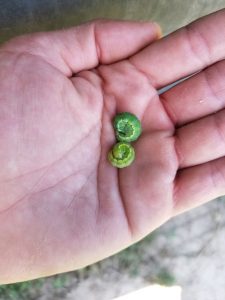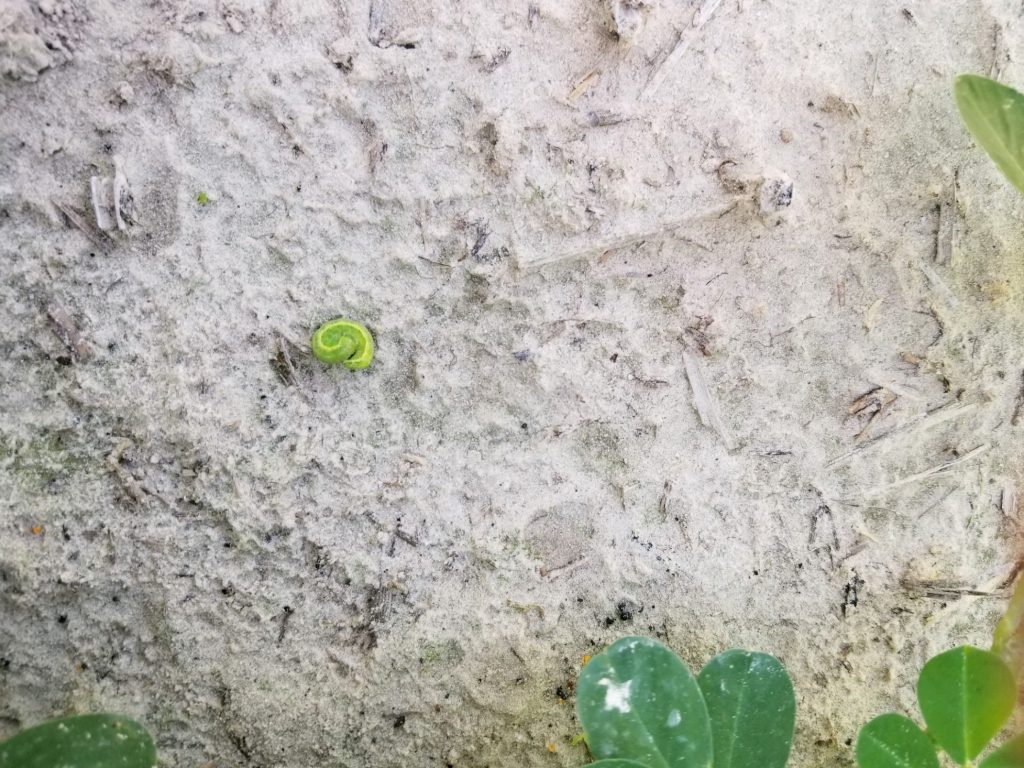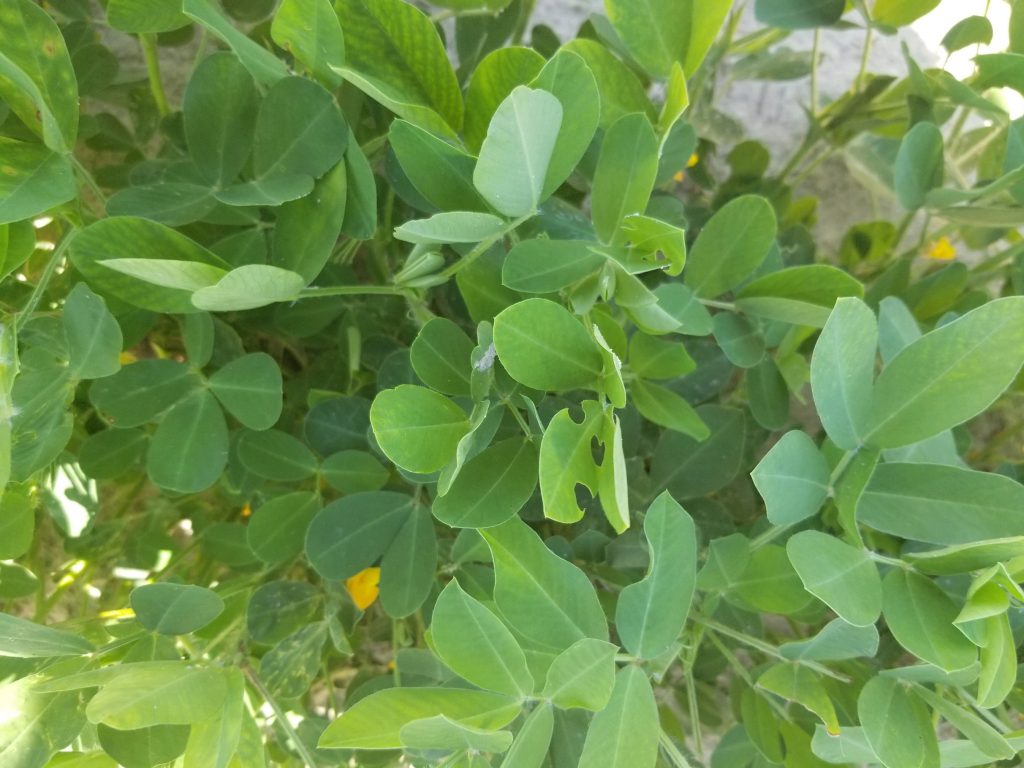- The new 2019 Virginia Peanut Production Guide is available at this link https://pubs.ext.vt.edu/SPES/SPES-67/SPES-67.html
- This guide describes peanut production practices including cultivars, planting, management, and harvest. Under management, information is provided on the optimum time for nutrient and irrigation applications; describes rotations effect on yield; soil preparation, etc. It also identifies major pests for the region including weeds, insects and disease, and how those to be controlled.
- Archived Peanut Production Guides can be accessed from: http://www.sites.ext.vt.edu/newsletter-archive/peanut-production/index.html
Category Archives: Peanut
Peanut harvest is coming sooner than we thought this year!
Friday, Sep 7th, a pod-blasting clinic was organized in Windsor, Isle of Wight County in Virginia. Farmers brought samples for maturity evaluation from 40 fields, in majority from the IOW but a few were from Suffolk and Southampton. Samples were taken from fields totaling a minimum of 3100 acres of peanut. Based on the mesocarp color, we identified that one sample was ready to dig, 12 in a week, 15 in a week and a half (10 days), 8 in two weeks, and 4 in three weeks or more. This indicated that two thirds of these fields were ready for digging after this week and after the hurricane Florence has passed.
Peanut varieties planted were in majority Bailey and Sullivan with only very few acres of Wynne and Emery, the last being a new cultivar just released in 2015. On these checked fields, farmers did not irrigate and only one farmer used Apogee, a growth regulator that could have affected maturity. Defoliation due to leaf spot was almost absent in all fields, as it was rootworm damage.
The earliest to be dug, in no more than a week, were fields planted during the first week of May and receiving constant rainfall in June, July, and August. Note that precipitation received in July and August exceeded by far this year the multi-annual average for most fields. Some fields planted in mid-May and constantly rained out, also showed digging approaching in 7-10 days (picture below).  The only early May plantings a little behind, 10-14 days from digging, were fields with a dry June, regardless if for the rest of the summer they were wet; and the majority of fields planted in mid-May. Based on the color charts, the fields planted during the last week of May could wait three weeks or more before digging. Meanwhile, several other pod-blasting clinics will be organized to help farmers decide when and what fields to start digging with.
The only early May plantings a little behind, 10-14 days from digging, were fields with a dry June, regardless if for the rest of the summer they were wet; and the majority of fields planted in mid-May. Based on the color charts, the fields planted during the last week of May could wait three weeks or more before digging. Meanwhile, several other pod-blasting clinics will be organized to help farmers decide when and what fields to start digging with.
This result came to no surprise. It has been determined that Bailey requires about 2700 °F heat units (or GDD) to reach optimum maturity. The Cotton – Peanut Infonet online service provided by Virginia Tech here https://webipm.ento.vt.edu/cgi-bin/infonet1.cgi shows that by Sep 7th peanut planted on May 1st received 2649 °F in Suffolk, 2637 °F at Capron in Southampton, 2718 °F at Skippers in Greensville, and 2640 °F at Waverly in Sussex. Researchers at the University of Georgia determined that every event of rainfall and irrigation received by a crop at one inch or above has an effect equivalent with 10 °F heat units and can speed up peanut maturity. If so, 100 or 200 heat units are to be added to those measured by the thermometer. Indeed, under the conditions of this year early May planted peanuts are expected to be ready for digging 7 to 10 days sooner than last year.
Peanut Fall Events
Peanut Extension activities will continue this Fall. Interested to see what future peanut varieties look like? Then come here Martin Field Day Flyer. Or maybe willing to learn more on peanut production from peanut specialists, and interested in finding when is the optimum time to harvest your peanuts? Then you are welcome here VA PEANUT Upcoming Events – 2018.
2018 survey of field corn for corn earworm larvae
Statewide, approximately 18% of ears were infested with corn earworm larvae. Corn is considered a nursery crop for corn earworm, allowing the pest to complete a lifecycle and then move on to other crops such as soybean, cotton, and peanut in August. There is a linear correlation between the infestation level in corn and the amount of soybean acreage that gets treated with insecticide for this pest. Please see the attached pdf for more details: CEW_survey_results_2018
Virginia Peanut Field Tour
A Peanut Tour will take place at the Tidewater AREC (1045 Hare Road, Suffolk, VA, 23437) on Aug 15. Presentations include precision irrigation and crop stress sensing, weed control and tank mixes, and disease and insect management. Meetings with the new Extension Agents in the Southeastern region will be facilitated. A new rotary peanut harvester by AMADAS will be displayed. The flyer with more details is here. Aug 15_Flyer(5) Please do not forget to call (757-807-6538) or email (mbalota@vt.edu) if you plan to attend. Hope to see you soon!
Corn earworm found in Virginia peanut fields
Peanut scouts in Suffolk today found fields with above threshold numbers of corn earworm/tobacco budworm (4 per row foot). Fields previously treated recently with chlorpyrifos may be at higher risk because they have fewer beneficial predators.
Black beat cloths can aide in sampling. However, shaking and slapping plants will dislodge worms onto soil for easy counting. Make sure and check around the base of the plant when using either method.
Feeding damage shows up in the form of holes in foliage. Worms may also feed on terminals and flowers so scouting for damage alone is not recommended. Peanuts can lose a lot of leaf material without losing yield, but drought-stressed or herbicide injured plants are at higher risk for yield-loss. Do not spray unless necessary. Recent dry weather in combination with broad-spectrum insecticides can flair spider mites.
Pyrethoids are a common choice for earworm control in Virginia and most products can be tank mixed with a fungicide to save money. Always read and follow label instructions. Pyrethroids are losing efficacy against earworm and we have experienced spray failures in other crops (soybean, cotton, sweet corn). Budworm have been resistant to pyrethroids for some time. You will not be able to distinguish these two species in the field. Refer to NCSU video for details. Do not expect complete control of large worms or high populations. Alternative products labeled in peanut include Prevathon, Besiege, Steward, Radiant, Intrepid Edge, and Blackhawk. A list of products and rates is included in Virginia Tech’s Pest Management Guide.
Peanut iPiPE and Disease Advisories
Especially with all the wet weather we have been having in much of the region, it is time to start thinking about peanut diseases. We do not typically see a lot of disease until the canopy closes, but once the vines are touching the environment within the canopy becomes favorable for disease development. Leaf spot programs should be applied beginning at early beginning pod then according to a calendar-based (usually 14 day intervals) or advisory based program. The leaf spot advisory for Virginia can be found at https://webipm.ento.vt.edu/cgi-bin/infonet1.cgi. Some keys to a successful leaf spot fungicide program include:
- Make the first application at the appropriate time (not too late).
- Apply fungicides regularly before leaf spot outbreaks are observed (once disease is present it is difficult to slow down the epidemic).
- Stick to a regular calendar-based program or utilize leaf spot advisories.
- Be mindful of fungicide resistance management (rotate chemistries and/or tank mix with chlorothalonil).
- Scout for soil-borne diseases and utilize fungicides with activity against both leaf spot and other target diseases (e.g. for both late leaf spot and southern stem rot control use a product such as Provost, Elatus, Priaxor, etc.).
Data are currently being collected to improve both leaf spot and Sclerotinia advisories and to develop a southern stem rot fungicide advisory for peanut. This is being conducted through the Peanut iPiPE program. The Integrated Pest Information Platform for Extension and Education (iPiPE) is a program that allows farmers and extension agents to share information with each other through the internet. iPiPE works by allowing users to enter pest data such as presence and severity of diseases or insects. This data will be shared with everyone in an effort to create a more precise system of pest monitoring and management. The Plant Pathology program at the Virginia Tech Tidewater AREC is leading the Peanut iPiPE and using it to improve disease advisories based on observations of disease onset in peanut fields throughout the region. Two undergraduate interns are currently scouting for peanut diseases in the region, and they will enter disease observations into the iPiPE database.
Disease and pest observations can be easily uploaded to the database through a mobile phone app or the online platform. We are encouraging anyone who scouts peanuts to help us collect disease observations. To become a participant, you can request an iPiPE account by visiting the iPiPE platform (http://www.ipipe.org/). Detailed information on the iPiPE platform and a user guide for the mobile app can be downloaded below. Alternatively, you can email disease observations to Dr. Hillary Mehl (hlmehl@vt.edu). In addition, if you are located in southeastern Virginia or northeastern North Carolina and are interested in having your peanut crop scouted for diseases by our iPiPE interns, please contact us.
Peanut iPiPE Stakeholder Card 2018
For more information or questions regarding the Peanut iPiPE contact Dr. Hillary Mehl (hlmehl@vt.edu).
2017 Field Crop Disease & Nematode Management Trials
A summary of field crop disease and nematode management trials from 2017 is now available. Results for applied research on wheat, corn, cotton, peanut, and soybean can be downloaded below.
Recommended Peanut Seeding Rates for Virginia
Research data, such as those here Seeding Rate-May 2018, showed that saving seed at planting does not return high yields or economic profit. To achieve high yields, we recommend planting 5 or 6 seeds per foot of row, assuming a germination of 80% and above. This is in particular necessary for large seeded cultivars like Emery and Wynne, and under irrigation. If germination is lower than 80%, which may be the case this spring for some seed lots of Wynne and Sullivan, 6 to 7 seeds are safe to plant but nothing above that. At least, we have not recently tested or heard of a benefit to increase the seeding rate above 7.
Imidacloprid effect on inoculant in peanut
There are concerns that imidacloprid-based insecticides for thrips control may negatively affect Rhizobia in inoculants when tank-mixed and applied in the furrow when plating peanut. As we are just a week (or less) from starting peanut planting in Virginia, I thought this issue be addressed for the farmer’s peace of mind if they decide to mix Optimize Lift inoculant with Admire-Pro insecticide for in-furrow seed treatment. I personally have not looked into this issue before, because we have not seen any effects in research plots or received complaints from farmers. However, we will research this aspect in 2018.
Meanwhile, colleague Dan Anco, Peanut Specialist at Clemson University, tested the effect of different tank-mixtures for in-furrow applications on the nodule number and peanut yield in 2015 and 2017. Graciously, Dan shared this information included in the In_furrow tank mixes tables. The results clearly show no effect of mixing Optimize Lift with Admire-Pro on peanut yield in both years (Tables 1 and 2), even when the number of nodules from this mixture appeared to be reduced by the use of Admire-Pro in 2017 (Table 2). David Jordan, Peanut Specialist at North Carolina State University, reported similar findings Peanut Science Inoculant CFTGM Peanut Inoculant.



